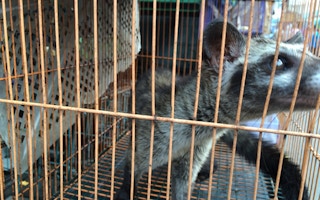A recent analysis of the legal wildlife trade in the last 46 years puts Indonesia, a biodiversity hotspot in Southeast Asia, among the top 10 exporters of live animals.
The research, published Nov. 11 by Oslo-based outdoor and nature website Outforia, looked into data from CITES, the global convention on the international wildlife trade, from 1975-2021. It puts Indonesia at No. 9 on the list of 80 countries (led by El Salvador), with 7.7 million live animal exports since 1975. The most traded animal from Indonesia, at more than 2 million live specimens, is the arowana fish, from the rivers of Borneo and Sumatra that’s highly prized in the aquarium trade across Southeast and East Asia. Arowanas (Scleropages spp.) were also the No. 8 most exported live animal in the last 46 years, according to the research.
These all constitute legal trades, regulated by authorities in Indonesia and in the importing countries, and registered in the CITES Trade Database. The role of CITES is to closely regulate the legal wildlife trade to ensure it doesn’t adversely affect wild populations of the species being traded.
But even though these trades are legal and monitored, countries with rich biodiversity like Indonesia should be trying to minimise them and focusing more on conserving the ecosystems in which these species are found, said Sunarto, a research associate at the University of Indonesia’s Institute for Sustainable Earth and Resources.
Profits from live animal exports should be allocated to beef up monitoring, management and protection of wildlife and habitats, he added.
“If these [conservation] aspects aren’t fulfilled, then having a large export value isn’t something to be proud of,” he told Mongabay in an interview. “Instead, it should be something of a concern that needs to be looked into deeper so that changes and improvements can be made to policies and practices in wildlife management in the habitat and in captive-breeding facilities, and in the trade process.”
The persistence of the illegal wildlife trade, and its significant overlap with the legal trade, is seen by experts as a major threat to the conservation of many species in Indonesia, pushing some inexorably toward extinction. Some of the main export markets include Europe, the United States, Hong Kong, Malaysia and Singapore.
The Indonesian government has implemented some policies to better regulate the trade, including promoting captive breeding of species that may not typically be removed from the wild. However, conservationists say this provides traffickers an opportunity to “launder” illegally caught wildlife, by passing them through captive-breeding facilities as though they were born there.
Industry watchers point to the significant disparities between the numbers of animals exported from Indonesia declared as captive-bred, and the numbers of specimens that breeding facilities in the country are actually producing, or have the capacity to produce. These differences suggest that many exported live animals may be wild-caught specimens laundered through a captive-breeding facility.
Evidence of wildlife laundering already exists for some species in Indonesia. A 2011 study suggested that nearly 80 per cent percent of 5,337 green tree pythons (Morelia viridis) exported from breeding facilities between 2009 and 2011 were in fact caught in the wild in eastern Indonesia.
Sunarto said it’s important to remember the central role of Indonesia’s wildlife, which is to “safeguard the health of forests, which are our bastion against the climate crisis.”
Around 200 million legal trades in live animals globally have been recorded in the CITES Trade Database since 1975, with the peak occurring from 1999-2003, when around 7 million specimens were traded each year. The biggest single year for the trade was 2018, when 10.8 million live animal trades were recorded. Iguanas (family Iguanidae) are the most exported live animal globally, with 34 million traded legally in the past 46 years. They’re popular as exotic pets in many countries, although some are also acquired by zoos.
“Due to the growing consumer demand for animal products in the form of clothing, food and accessories the wildlife trade is vast and profitable,” Outforia wrote in the survey.
This story was published with permission from Mongabay.com.








